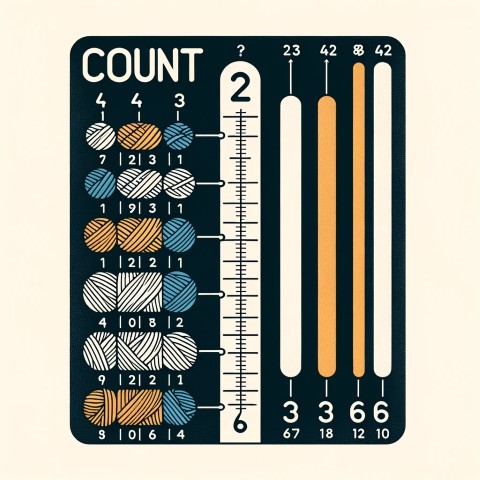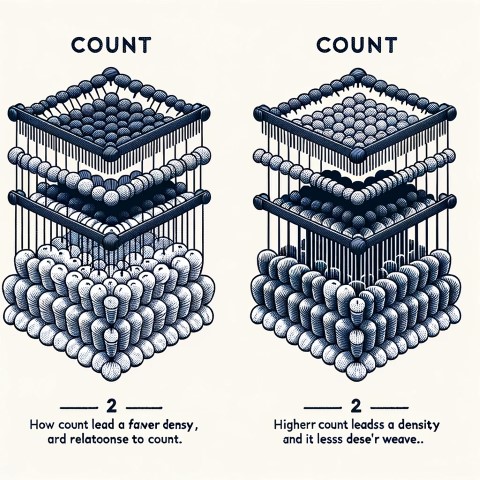Last Updated on: 12-Apr-2024 (3 months, 15 days ago)
Share on Facebook • Share on Twitter
Count in Textiles: Deciphering the Fabric of Innovation
Introduction: Exploring the Significance of Count in Textiles
Count, a fundamental concept in the textile industry, holds immense importance in fabric production and quality assessment. It refers to the measurement of yarn thickness or density, influencing the characteristics and performance of textiles.
Understanding the concept of count is crucial for textile professionals, as it directly impacts various aspects of fabric design, construction, and application. By examining the count of yarns used in weaving, knitting, or other textile processes, manufacturers can determine the fabric's weight, strength, and appearance.
The significance of count extends beyond fabric production, playing a key role in consumer preferences and industry standards. Different counts are preferred for specific applications, such as fine counts for delicate apparel and coarse counts for heavy-duty fabrics like canvas or upholstery.
Moreover, advancements in textile technology have led to the development of specialized counting methods and instruments, enhancing accuracy and efficiency in the measurement process. This allows textile engineers and designers to achieve precise control over fabric characteristics, ensuring consistency and quality in production.
In this article, we will delve deeper into the concept of count in textiles, exploring its various types, measurement techniques, and applications across different sectors of the textile industry.
Brief History and Types of Count in Textiles
The concept of count in textiles dates back centuries, originating from the need to standardize yarn thickness for consistent fabric production. Early civilizations used rudimentary methods to measure yarn count, such as wrapping yarn around fixed lengths of sticks or stones. Over time, as textile manufacturing evolved, more precise counting techniques emerged, leading to the development of standardized systems for yarn measurement.
- Tex: Tex is a metric unit representing the weight of yarn in grams per 1000 meters. It measures the linear density of yarn, indicating its thickness or fineness.
- Denier: Denier measures the weight of yarn in grams per 9000 meters. It is commonly used for filament yarns, such as those used in synthetic fabrics like nylon and polyester.
- Ne: Ne is a system used to measure the count of yarn in cotton, wool, or other natural fibers. It represents the number of hanks (840 yards) of yarn per pound.
- Decitex: Decitex is another metric unit used to measure yarn fineness, representing the weight in grams of 10,000 meters of yarn.
- English Cotton Count (ECC): ECC is a count system specifically used for cotton yarn, representing the number of 840-yard hanks per pound.
Tips for Handling and Maintaining Yarn Count:
- Consistent Tension: Maintain consistent tension during spinning and weaving to ensure uniform yarn count throughout the fabric.
- Regular Calibration: Calibrate counting instruments regularly to ensure accurate measurement of yarn count.
- Quality Control: Implement strict quality control measures to identify and rectify any deviations in yarn count during production.
- Proper Storage: Store yarns in a controlled environment with stable humidity and temperature to prevent moisture absorption or drying, which can affect yarn count.
- Optimized Processing: Optimize processing parameters such as speed, tension, and yarn twist to achieve the desired yarn count and fabric characteristics.
Applications of Count in Textiles
- Fabric Production: Count plays a crucial role in fabric production, determining the density, weight, and texture of the final product. Different counts are used for various fabric types, such as lightweight cotton fabrics requiring finer counts and heavy-duty upholstery fabrics requiring coarser counts.
- Quality Assessment: Yarn count serves as a vital parameter for assessing the quality of textile materials. Manufacturers use count measurements to ensure consistency and uniformity in yarn thickness, which directly impacts the overall quality and performance of the finished textile products.
- Textile Design: Designers utilize yarn count variations to create unique textures and patterns in textiles. By selecting specific counts and blending different yarn types, designers can achieve desired aesthetic effects, enhancing the visual appeal and tactile properties of fabrics.
- Technical Textiles: In technical textiles applications, such as geotextiles, medical textiles, and automotive textiles, precise yarn count specifications are essential for meeting performance requirements. Engineers and designers specify yarn counts to ensure durability, strength, and functionality in specialized textile applications.
- Global Trade: Yarn count standards facilitate international trade by providing a common language for describing textile materials. Consistent count measurements allow manufacturers, suppliers, and buyers to communicate effectively and ensure product quality across global supply chains.
Profiles of Major Manufacturers/Users of Count in Textiles
- Gildan Activewear: Gildan Activewear is a prominent manufacturer of basic apparel, including T-shirts and fleece, known for its high-quality yarn counts and consistent product offerings.
- Shandong Ruyi Technology Group: Shandong Ruyi Technology Group is a leading textile conglomerate in China, recognized for its extensive expertise in yarn count variations and production efficiency.
- Tata Textile Mills: Tata Textile Mills is a renowned Indian textile company with a diverse product portfolio, including yarns of various counts tailored to meet the demands of different textile segments.
- Lenzing AG: Lenzing AG is an Austrian company specializing in sustainable fibers such as TENCEL, known for its precise control over yarn counts and commitment to environmental responsibility.
- Unifi, Inc.: Unifi, Inc. is a global leader in recycled and synthetic yarns, offering a wide range of yarn counts for applications in apparel, automotive, and home furnishings industries.
Conclusion: Navigating the Threads of Textile Innovation
As we conclude our exploration into the realm of yarn count in textiles, it becomes evident that this seemingly simple metric holds significant importance in the textile industry's intricate web of innovation and production. From the meticulous calculations of thread density to the practical implications of yarn count variations on fabric properties, the journey through the world of count has revealed its multifaceted nature and indispensable role in textile manufacturing.
Through our examination of various yarn count types, tips for handling, and profiles of major manufacturers, we have gained insight into the diverse applications and expertise present in this field. Companies such as Gildan Activewear, Shandong Ruyi Technology Group, Tata Textile Mills, Lenzing AG, and Unifi, Inc., exemplify the breadth of knowledge and innovation driving advancements in textile production.
Looking ahead, as technology continues to evolve and sustainability becomes increasingly paramount, the significance of yarn count in achieving desired fabric characteristics while minimizing environmental impact cannot be overstated. As textile professionals and enthusiasts alike continue to navigate the threads of innovation, understanding the intricacies of yarn count will remain essential for creating fabrics that meet the diverse needs of consumers and industries worldwide.
�A numerical designation of yarn size indicating the relationship of length to weight.
The number of warp yarns (ends) and filling yarns (picks) per inch in a woven fabric, or the number of wales and courses per inch in a knit fabric. For example, a fabric count of 68 x 52 indicates 68 ends per inch in the warp and 52 picks per inch in the filling.
Some more terms:
Bleeding
In the textile industry, "bleeding" refers to the phenomenon where dyes or pigments used to color fabrics leach out or migrate from the fabric when exposed to moisture, such as water or sweat. This...
Read about BleedingRayon Ingredient
A manufactured fiber composed of regenerated cellulose, as well as manufactured fibers composed of regenerated celluluse in which substituents have replaced not more than 15% of the hydrogens of the...
Read about Rayon IngredientRatine
Ratine is a type of textured fabric that is often used in the production of clothing and home textiles. The fabric is characterized by its unique, bumpy texture that is created by the use of slubbed...
Read about RatineRobe Chronicles: A Comprehensive Journey Through History and Culture
A robe is a loose-fitting outer garment of various types, including: A gown worn as part of the academic dress of faculty or students, especially for ceremonial occasions, such as a convocations or...
Read about RobeSpin Drawing
Spin drawing is a textile technique that involves the creation of intricate designs and patterns on fabric using specialized spinning equipment. It is a unique and innovative method that combines...
Read about Spin DrawingSchiffli Embroidery
Schiffli Embroidery is a highly intricate and decorative technique of embroidery commonly used in the textile industry. It involves the use of a specialized embroidery machine known as a Schiffli...
Read about Schiffli EmbroideryBowing
Usually caused by finishing. Woven filling yarns lien in an arc across fabric width: in knits the course lines lie in an arc across width of goods. Critical on stripes or patterns and not as critical...
Read about BowingElasticity
The property of material to deform (usually to elongate) in proportion to the load applied and to recover its original shape when the load is release, i.e. the property of a material by virtue of...
Read about ElasticityOn this page
Add a definition
- The term you want to define
- Its definition in 500 words or less
- Attach an image if necessary.
- Optionally, tell us about yourself in 200 words or less!
Companies for count:
- Company name
- Company address
- Attach a logo, if necessary.
- Optionally, tell us about yourself in 200 words or less!

 The city of Pirojpur is seeing growth in its textile and garment industry.
The city of Pirojpur is seeing growth in its textile and garment industry.



